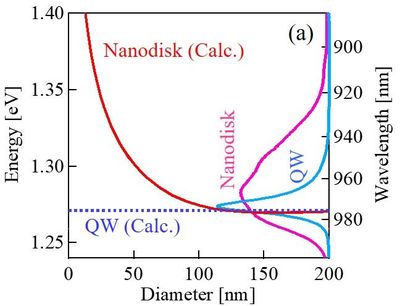PRESS RELEASE
- Research
- 2019
Photoluminescence of InGaAs/GaAs Quantum Nanodisk in Pillar Fabricated by Biotemplate, Dry Etching and MOVPE Regrowth
Authors
Akio Higo, Takayuki Kiba, Junichi Takayama, Chang Yong Lee, Cedric Thomas, Takuya Ozaki, Hassanet Sodabanlu, Masakazu Sugiyama, Yoshiaki Nakano, Ichiro Yamashita, Akihiro Murayama, and Seiji Samukawa
Abstract
III-V compound semiconductor quantum dot (QD) photonic devices have attracted considerable attention due to their stable operation at high temperature, low threshold current, and high-speed modulation. The photoluminescence (PL) energy of QDs depends on the dot sizes and the energy height of barriers. It is difficult to encourage the growth of low indium content QDs because of small lattice distortions between the InGaAs well regions and GaAs barrier regions. In conventional self-organized QD devices produced by Stranski–Krastanow growth methods, the injected carriers are first captured by the wetting layers, then dropped to the QDs with relaxation to the ground state for QD devices. Our proposed unique quantum disk structures have no wetting layers because the quantum well (QW) region is fully etched using a low-damage dry etching process. We produced 30-nm-diameter and 9-nm-thick InGaAs nanodisks using a biotemplate, via neutral beam etching and metalorganic vapor phase epitaxy (MOVPE). We observed the InGaAs nanodisks via scanning electron microscopy and measured their photoluminescence (PL). To confirm the quantum confinement effects of InGaAs nanodisks, their energies and transient PL behaviors were measured as a function of temperature. The combined low-damage dry etching and MOVPE regrowth processes form an important technique, as they promise a low-damage interface and regrowth ability. This unique technology is attractive for carrier transportation dynamics and spintronics of hybrid QDs and QW nanostructures, and it is easy to adapt for industrial production systems.

ACS Applied Electronic Materials:https://pubs.acs.org/doi/10.1021/acsaelm.9b00432

